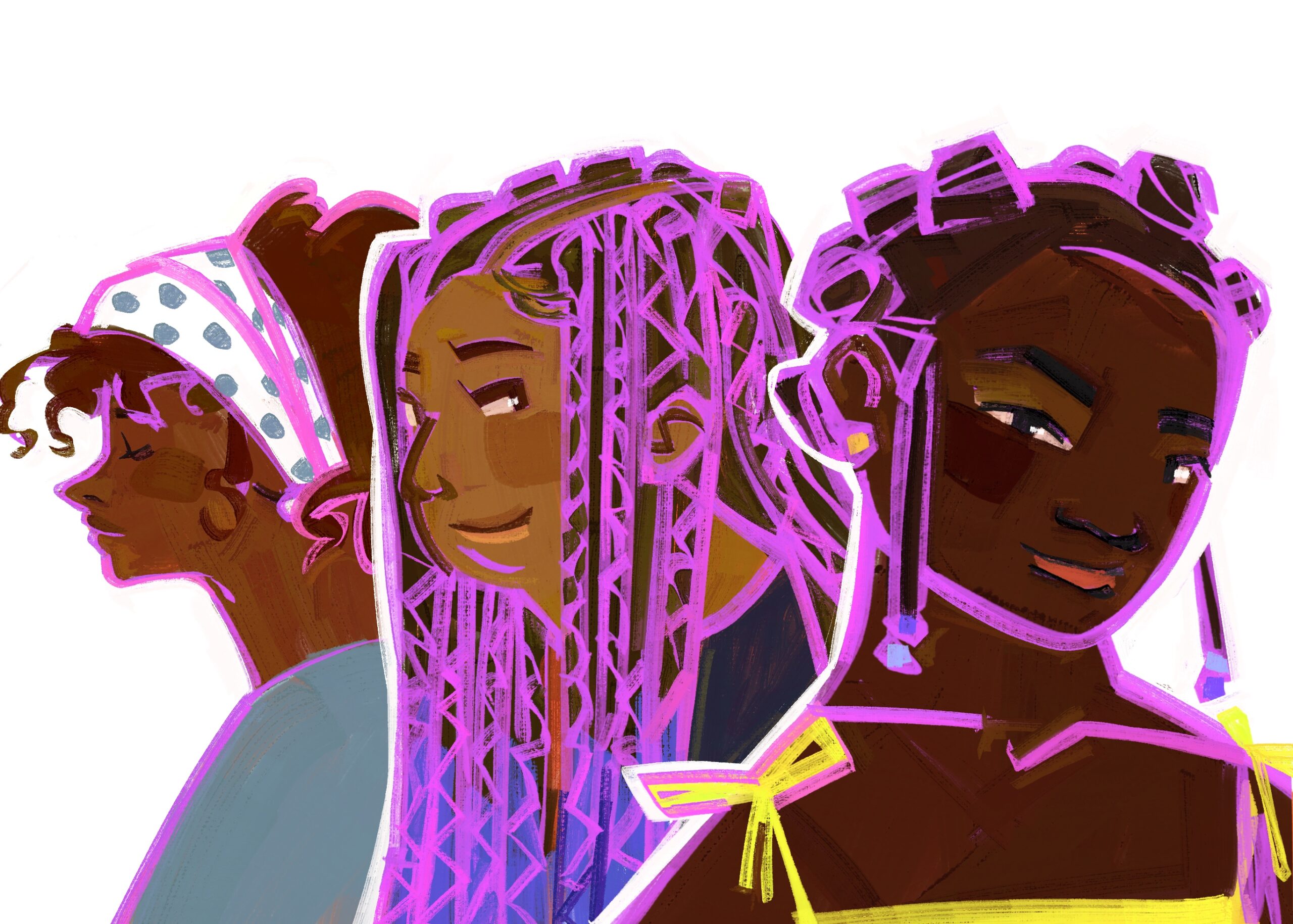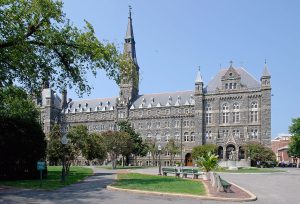When Fathia Fasasi (SOH ’27), the resident director of Black House—a residential space and cultural hub for Black students—came to Georgetown, she was surprised at the lack of spaces on campus and in the neighborhood for Black hair.
“At first it was a shock because yes, I knew I was going to a PWI (predominantly white institution), but can I have a beauty supply store down the street?” Fasasi said.
Black women at Georgetown don’t have the privilege of easy access to hair supplies and shops that cater to their hair type. This lack of accessibility has made their time at Georgetown noticeably more difficult. This absence of appropriate hair care has spurred a movement in the university to build community around Black hair.
Inaccessibility of Black hair care at Georgetown
Although Black women knew that they would be attending a university that wasn’t majority Black, like a Historically Black College or University (HBCU), they were still surprised when they stepped foot into Georgetown’s neighborhood, a place that had no spaces meant for their hair.
The Georgetown neighborhood has a noticeable demographic difference from the rest of D.C. Around 75% of its residents are white, and 6% are Black, while D.C. is roughly 35% white and over 45% Black.
Many Black women said their experience of hair care at Georgetown was completely different from their hometowns. At home, they could find hair products a couple of blocks away, in beauty supply stores, stores where Black women can purchase braiding hair and necessary products or supplies.
They also didn’t have to worry about hairstylists around them not knowing how to style type 4 hair. Type 4 hair is a common hair type of Black people, and is characterized by tighter curl patterns, ranging from visible to dense coils.
Princess Diallo (CAS, MSB ’28), the co-vice president of Black Student Alliance (BSA), grew up in West Africa, Guinea, and moved to a predominantly Black neighborhood in Brooklyn, N.Y., three years ago.
“We have a lot of supply stores,” Diallo said, referring to her home in Brooklyn. “For example, from my house, you just have to walk down two blocks, and then you see a hair salon and then a beauty supply store.”
In contrast, not only are there no beauty supply stores in the Georgetown neighborhood, but there also aren’t any hair salons that specialize in styling type 4 hair. This type of hair is fragile, and the process of taking care of it is different from other types of hair. Having stylists who understand the process ensures that a Black woman’s hair won’t be damaged at the visit and provides a sense of security for those getting their hair done. However, this isn’t an option in Georgetown.
“Georgetown has a lot of white hair salons. We couldn’t easily go to them, for them to give us a silk press or anything like that,” Synai Harris (CAS ’27), a student who sometimes does hair on campus, said. “Being able to have access to that and be in the presence of somebody you feel comfortable to do your hair, who understands it. It makes you feel seen.”
Black women also have a challenging time finding hair products specifically made for Black people and type 4 hair in retail and drug stores around Georgetown, according to Melissa Munroe (MSB ’27), co-president of the Caribbean Culture Circle (CCC) and co-creator of the Georgetown Greenbook, a resource guide for Black students.
“You don’t think that something as simple as taking care of your hair can be such a racial barrier,” Munroe said. “Rarely can I go to CVS and buy curly hair products or shampoo and conditioner that works.”
When there are products that work for type 4 hair in stores such as CVS or Target, they tend to be overpriced compared to beauty supply stores, according to Myla Taylor (SFS ’27), a Black House resident and co-creator of the Georgetown Greenbook.
Some students have decided to go near Howard University, an HBCU, to find beauty supply stores. They have found more luck in that area than in the Georgetown neighborhood.
“I go to a place called Beauty Island, near Howard Theatre, to get my hair stuff,” Munroe said. “They have everything that you could ever need.”
Financial costs of hair care
Because of the lack of hair care at Georgetown, Black women like Harris travel to Howard University sometimes for hair care. She would look at Howard Hustles, a social media page that promotes Howard students’ businesses, to find hairstylists, but she found the cost of the services and the long commute to Howard to be too much.
“It’s very affordable, compared to D.C., where I have to travel all the way to Howard,” Harris said, referring to hair care at home. “Getting [from] Georgetown to Howard is a hassle.”
To keep costs low, some students have turned to online stores, such as Amazon. However, it isn’t as convenient as one might initially think. Ordering online comes with its own set of problems, Fasasi said. When online stores make errors, the process of correcting those mistakes and getting the products or hair one needs is a process.
“Last time I ordered hair on Amazon, it was the wrong color that I dyed my hair,” Fasasi said. “So I’m like, ‘this is awkward.’ You have to do the return. It’s just too much. Whereas, if it was a beauty supply, I can just go down the street.”
When students do want to have their hair styled in a protective style or in other ways, they find that there are no suitable hairstylists near the Georgetown neighborhood. Protective styles are meant to protect the natural hair and are long-term hairstyles that can last for a few weeks to months. Some protective styles include knotless braids, faux locs, cornrows, and wigs.
Some students choose to go deep into Maryland or Virginia. The cost of transportation, in addition to the cost of the hair and the hairstyle, can be expensive for students.
“So first for you to access there, you cannot take the bus or the train, so that means you have to Uber. And where I go is usually 47 minutes, so the Uber cost me around like $30,” Diallo said. “And knowing how Black people’s hairstyles are expensive, the minimum starts at like $200. So adding that to the cost of transportation it’s a lot, so it has been hard.”
To help with the cost, many of the Black women have found that stocking up on supplies is the easiest solution. They will go home and bring back multiple supplies to reduce the number of times they need to go out of the Georgetown neighborhood and buy something.
“One product, I have two sets of it,” Diallo said. “If we did [have] those types of products around here, I would just bring one. And then when it’s done, I can go around D.C. and buy it.”
Balancing hair care with college life
Due to the limited accessibility, Black students have had to get creative when maintaining their hair. Some Black women have decided to create calendars detailing their hair maintenance routine, in addition to having a calendar with their class schedule and other activities.
“A lot of my Black girl friends [and I], we have hair calendars,” Munroe said. “Like, ‘how long is this gonna take me to do? How long can I keep this in?’ I can keep this in for three weeks. After that, my hair needs a break.”
Even with these schedules, at Georgetown, students have to focus on their academics and other commitments, so many Black students feel their hair is the one thing that doesn’t get a lot of attention.
“When I was younger, when I was in high school, I had more time to take care of my hair, and here, being at Georgetown, is a 24-hour day, 24/7 job,” Munroe said.
The Black women on campus are students first, so most of their time is spent doing homework or on campus activities. This leaves little time to take care of their hair, which is why they say it’s best to have everything they need early on. In Munroe’s room, she has a stock of twist hair, loc hair, braiding hair, and gel, all products she can use when she needs to do her hair.
“I know that going to beauty supply stores can be a lot to ask, especially when running clubs and doing extracurriculars, and like needing to do homework and final season, it just all comes down at once,” Munroe said. “And hair, even though it’s easy for a lot of people, it becomes a lot.”
Misconceptions about Black hair
Coupled with the lack of access to Black hair care, Black students said there is a lack of awareness around Black hair.
Harris said that she wished people didn’t judge her or other Black people for wearing a bonnet or scarf on campus. When Black students don’t have time to do their hair in the morning or if they are running a quick errand, putting something over their hair is the best option. Wearing a bonnet or scarf outside is normal for Black people, but Harris said that since she has been at Georgetown, she gets weird stares.
The limited knowledge about type 4 hair leads to Black women on campus being asked questions about their hair constantly.
Fasasi said that she wished other students knew that Black hair is versatile, stating that she enjoys customizing her hair by cutting it and dyeing it whatever color of her choice.
Diallo experienced a similar lack of knowledge among Georgetown students. She said that multiple people would ask if she cut her hair or if she got extensions after each style.
Diallo’s experience is something that other Black women have when they opt for a protective style over their natural hair. These hairstyles take less effort to maintain than natural hair, which is an appealing option for Black students at Georgetown.
“I try to use protective styles most of the time, because when it’s finals, when I need to do my hair, I can’t. That type of maintenance takes a really long time.” Munroe said. “Wash day for a Black girl or any person with coarse hair or long hair, it takes a very long time, and I can’t even carve out that time on a weekend when you’re supposed to have extra time.”
Culture and representation
In the Black community, though, hair is more than just hair—it’s a way for the culture to connect based on similar experiences.
Harris is the oldest sibling and grew up doing her sisters’ hair because their mother couldn’t afford to get all of their hair done. Though it was difficult to learn how to do hair at first, she continued to practice and improved, mastering the knowledge of how to part their hair and pay attention to their head shape.
In contrast, Fasasi’s sister was a hairstylist, so she never worried about having to go and get her hair done. Since being at Georgetown and away from her sister, she has learned how to do some styles, like braids, herself.
Similarly, Munroe said doing her own hair is a rite of passage as a Black woman. It gives her a direct connection to her mother, who would make her own wigs. Now, Munroe knows how to do her own hair.
“I have had the privilege of knowing how to do my own hair [and] having people in my family that know how to do hair, so I’ve never had to pay for hair before,” Munroe said. “A lot of the styles, I know how to do myself, and I even help my friends if they want to get their hair done. I’ll do it for them because it’s hard to find braiders.”
The presence of beauty supply stores and hair salons means a lot to Georgetown’s Black women. More than easy accessibility, they feel like they can be themselves.
“It means a safe space of not being judged,” Fasasi said about beauty supply stores. “That’s the only place I go with my hair looking crazy, braids not finished, two-tone hair dye, trying to figure out what color dye to match. It’s definitely a space where, for lack of a better word, I let my hair down.”
The beauty supply store gives more room for a Black woman to be able to experiment due to the wide variety of products available. Some Black women find that they can spend a lot of time there, but it’s far from time wasted.
“I think hair stores are just a sense of comfort,” Taylor said. “When I was little, I used to go to the beauty supply with my mom almost every weekend, and we would spend a good hour to two hours just looking at stuff, trying to figure out things to pick out.”
Diallo said that Black beauty supply and hair stores mean representation. They’re an indication that the Black community is around.
Creating spaces on campus
Despite Georgetown’s lack of access to Black hair care, in recent years, there have been more events for Black students focused on forming a community around hair.
Chop It Up is a recurring event on campus for Black men. The men are able to come together, be in conversation with each other, and get a free haircut.
However, Georgetown lacks similar events for Black women on campus.
“There’s really no equivalent for women, because obviously our hair doesn’t take an hour to do,” Munroe said. “[It] takes definitely 10 hours, especially when I do it myself.”
To fill this gap, Munroe and Taylor decided to restore the Black Book of Georgetown. Published in April 2020, it provided Black students with information about on and off-campus resources.
During their freshman years, the two became aware of it and decided to revive it. They announced the return of the resource guide on Sept. 26 this year under the name The Georgetown Greenbook.
The name references the Negro Motorist Green Book, a travel guide for Black people during the Jim Crow era, which provided them with resources to help them stay safe and as comfortable as possible.
The Georgetown Greenbook, which can be found on their Instagram page, features a list of resources, including beauty supply stores, as well as clothing and dining options. Black students looking for a nearby beauty supply store can look forward to the Georgetown Greenbook’s field trip to Beauty Island on Nov. 8 at 1 p.m.
“We wanted to provide different safe havens and different spaces in which Black students at Georgetown could gain access to resources and really embrace their Black identity,” Taylor said. “That extends to on-campus resources, but also off-campus resources.”
The book aims to highlight opportunities in D.C. made for and by the Black community, according to Taylor.
“D.C. as Chocolate City,” Taylor said, referring to D.C. being the first majority Black city in the United States. “We wanted to really highlight the different spaces and places in D.C. that are made for and by the Black community.”
This semester, there are more events around Georgetown that allow Black women to openly discuss their hair and learn about the resources around them to find the supplies they need.
On Nov. 13 at 6 p.m., the Women’s Center, BSA, CCC, and the Center for Multicultural Equity & Access (CMEA) will host a braiding bootcamp, which will teach how to braid, twist, and do other styles on a few different hair types. This event will also give away free hair products.
On Nov. 16, Black House will host a conversation about hair and hand out hair products.
Other than events put on by clubs or organizations, Black women who know how to style hair have decided to offer their services to other Black women at Georgetown. Harris does hair on campus and offers affordable prices for Black women looking to get their hair styled.
While they are providing a valuable service, hairstyling on campus also provides opportunities for community and supporting other Black women. Harris believes that it’s important to uplift Black women on campus and their skills or talents because it creates a community. But whether a Black woman is just getting started on learning a skill or if they have years of experience, putting themselves out there could help themselves and others.
“If any Black woman at Georgetown has a skill that they could be sharing with others, they should promote themselves,” Harris said.
In the meantime, for those committed to building community, her door is open.
“If you want to just take the risk and let me do your hair, it just gave people space to be like, ‘Okay, this is an affordable option, at least I can get it done right now,’” Harris said. “My whole thing is I just want to continue to grow, to give people an opportunity.”




